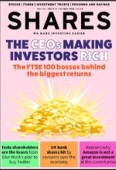Archived article
Please note that tax, investment, pension and ISA rules can change and the information and any views contained in this article may now be inaccurate.
Reasons why Amazon is not a great investment at the current price

For years many investors have viewed Amazon (AMZN:NASDAQ) as an undefeatable business that can do no wrong. Wherever it moved in the retail space, success swiftly followed. The rapid ascension of its cloud computing arm helped to drive big profits and the share price kept going up and up.
Having enjoyed a bumper period during the pandemic as households relied on the company for every product imaginable, it was natural to see the share price lose momentum as the world started to return to normality last summer.
Since November 2021 the shares have been on a downward trend, with a positive reaction to fourth quarter numbers in February one of the rare exceptions.
The reasons why the shares have trended lower include reduced appetite among investors for expensive growth stocks and, more recently, Amazon reporting its slowest growth for more than 20 years.
Someone who bought Amazon shares as a Christmas present for themselves last December (based on the last available price before the special day) would now be nursing a 23% loss. That leaves a sour taste.
If you’re an investor in Amazon, it’s only natural to ask if it is time to sell given the direction of the share price. Before answering that question, let’s look at the key points troubling the market.
In its latest quarterly update, online sales fell 3%, shipping costs increased 14% and operating profits fell year-on-year for the third time in a row. Amazon was cash-flow negative for the sixth time in eight quarters and net debt including leases has gone from $14 billion two years ago to $47 billion.
Over the past two years it has nearly doubled the number of employees to 1.6 million. Shipping and fuel costs remain stubbornly high and combined with year-on-year increases in wage inflation, inflationary pressures have added approximately $2 billion of incremental costs compared to 2021.
It needs strong growth in retail sales to justify having this very large workforce, particularly at a time when everyone is asking for a bigger salary. Sadly, that strong growth is currently missing.
Amazon may have to revisit its strategy with Prime delivery. As it stands you can order something that costs £3 and have it delivered the next day at no extra cost other than your annual Prime subscription. Theoretically you could make that same order every day for a year, and the delivery cost to Amazon must surely outweigh the income.
Admittedly, minimum order quantities are being imposed for items that might cost less than £1, but that doesn’t go far enough.
From a financial perspective, Amazon’s cloud computing arm AWS continues to save the day. It is growing fast and is incredibly profitable although competition could be a problem in the future.
Amazon is a pioneering business but it’s hard to justify paying 55 times forward earnings given the current state of the retail arm and the growing risk that consumer spending could tail off further in the coming months.
Yes, it’s an innovative company and over the years has bounced back from weak patches. Yet for someone actively managing their portfolio, it would make sense to get out of Amazon now and look to buy back at a lower level once there are signs that cost pressures are easing and consumers are not watching every penny.
Important information:
These articles are provided by Shares magazine which is published by AJ Bell Media, a part of AJ Bell. Shares is not written by AJ Bell.
Shares is provided for your general information and use and is not a personal recommendation to invest. It is not intended to be relied upon by you in making or not making any investment decisions. The investments referred to in these articles will not be suitable for all investors. If in doubt please seek appropriate independent financial advice.
Investors acting on the information in these articles do so at their own risk and AJ Bell Media and its staff do not accept liability for losses suffered by investors as a result of their investment decisions.
Issue contents
Feature
Great Ideas
- Find out why WH Smith remains an exciting Covid recovery play
- A tight power market continues to drive earnings upgrades at Drax
- Why we’re sticking with formidable long-run performer Fidelity Special Values
- 2022 should prove a pivotal year for GlaxoSmithKline
- Shares in comparison website owner Moneysupermarket are too cheap to ignore
- This is how to find a winning combination of cheap stocks and inflation protection

 magazine
magazine








